079 of
150: BCATP No. 8 BGS Lethbridge Official Opening
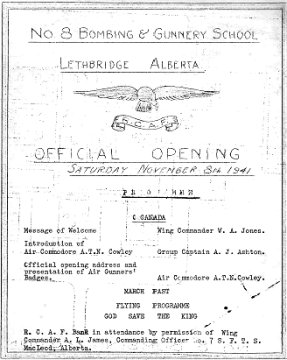
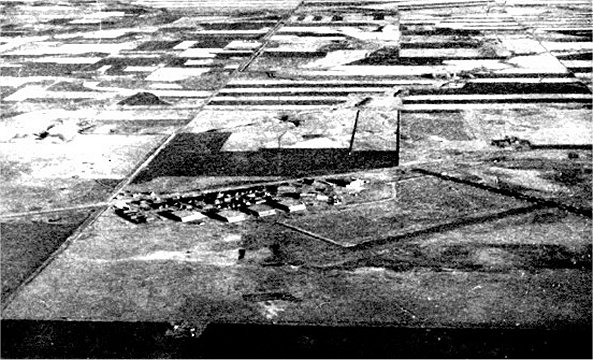 Introduction – The Official Opening of No. 8 Bombing and
Gunnery School, Lethbridge, Alberta was November 8, 1941. It was also the
day that the first Bombing and Gunnery Class graduated and received their
Wings. Earlier this year, we received a package of photographs and documents
from No. 8 BGS as a donation from Robert Quirk. In this Canada 150 Vignette,
We offer some digital copies of these archival materials from that day.
It would appear that the graduation took place inside one of the hangars
due to inclement weather.
Introduction – The Official Opening of No. 8 Bombing and
Gunnery School, Lethbridge, Alberta was November 8, 1941. It was also the
day that the first Bombing and Gunnery Class graduated and received their
Wings. Earlier this year, we received a package of photographs and documents
from No. 8 BGS as a donation from Robert Quirk. In this Canada 150 Vignette,
We offer some digital copies of these archival materials from that day.
It would appear that the graduation took place inside one of the hangars
due to inclement weather.
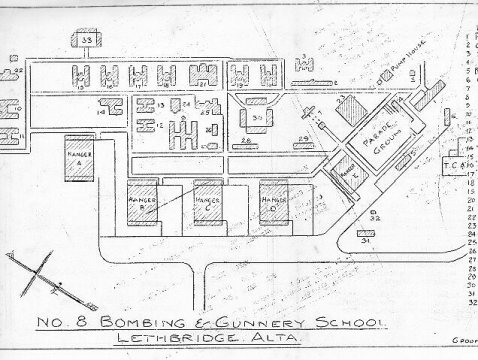
A MESSAGE FROM OUR COMMANDING OFFICER
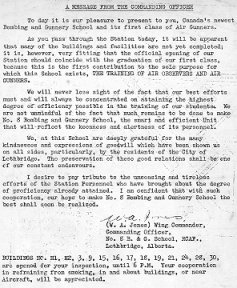 Today
it is our pleasure to present to you, Canada's newest Bombing and Gunnery
School and its first class of Air Gunners. As you pass through the Station
today, it will be apparent that many of the buildings and facilities are
not yet completed; it is, however, very fitting that the official opening
of our Station should coincide with the graduation of. our first class,
because this is the first contribution to the sole purpose for which this
School exists, THE TRAINING OF AIR OBSERVERS AND AIR GUNNERS.
Today
it is our pleasure to present to you, Canada's newest Bombing and Gunnery
School and its first class of Air Gunners. As you pass through the Station
today, it will be apparent that many of the buildings and facilities are
not yet completed; it is, however, very fitting that the official opening
of our Station should coincide with the graduation of. our first class,
because this is the first contribution to the sole purpose for which this
School exists, THE TRAINING OF AIR OBSERVERS AND AIR GUNNERS.
We will never lose sight of the fact that our best efforts
must and will always be concentrated on attaining the highest degree of
efficiency possible in the training of our students. We are not unmindful
of the fact that much remains to be done to make No. 8 Bombing and Gunnery
School the smart and efficient Unit that will reflect the keenness
and alertness of its personnel.
We, at this school are deeply grateful, for the many kindnesses
and expressions of goodwill which have been shown to us on all sides, particularly,
by the residents of the City of Lethbridge. The preservation of these good
relations shall be one of our constant endeavours.
It is our desire to pay tribute to the unceasing and tireless
efforts of the Station Personnel who have brought about the degree of proficiency
already attained. I am confident that with such cooperation, our hope to
make No. 8 Bombing and Gunnery School the best shall soon be realized.
(W.A. Jones) Wing Commander,
Commanding Officer,
No. 8 B & G School, RCAF.,
Lethbridge , Alberta.
BUILDINGS NO. Hl, H2, 3, 9, 15, 16, 17, 18, 19, 21, 24,
28, 30, are opened for your inspection, until 6 P.M. Your cooperation in
refraining from smoking, in and about buildings, or near Aircraft, will
be appreciated.
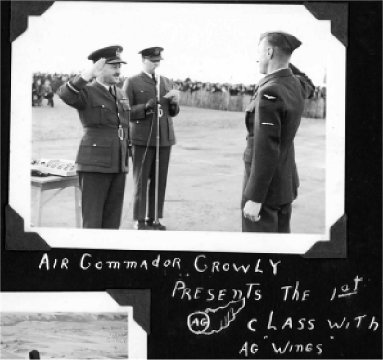
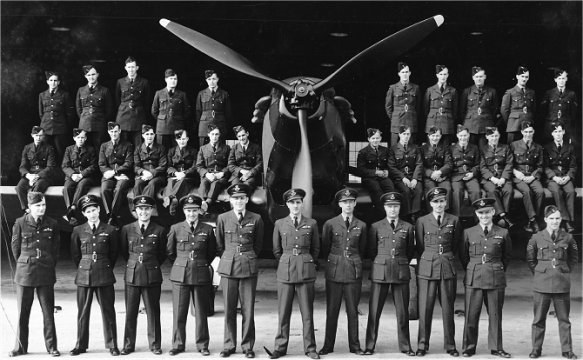
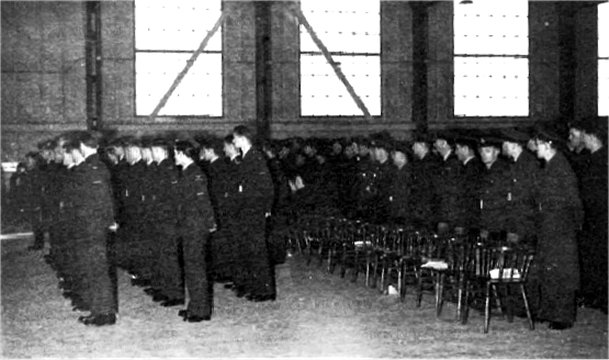
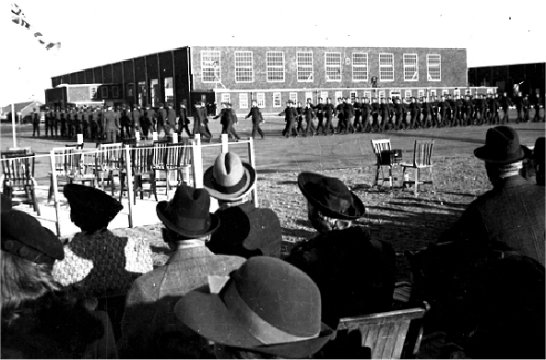
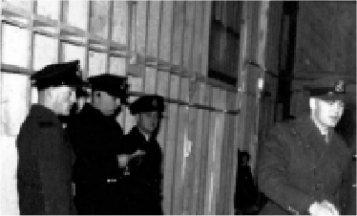
080 of
150: A WW II Memory - Sam and Glen Merrifield Part 5
Sam and Glen Merrifield continue
to give us their recollections of work and social life at the Pocklington
Air Base in Yorkshire, England.
Part 5 - During the summer of 1941 I remember being sent
on a crash party to a field atop a cliff on the English Channel near Plymouth.
One of our aircraft had made it home to England with maybe a hundred feet
to spare and belly landed. It was well shot up and we had to go and retrieve
our command set crystals and other gear before it was sent to the repair
depot. We were a party of two, the AEM being an RAF lad who had at one
time lived in Plymouth. We went down by train and then took a bus through
the city. It was a sight to see the center of the city where little remained
but a pile of rubble. From the upper deck of a city bus you could see over
the rubble as far as two or three roads either side.
After our work at the aircraft we had the evening to spend
and went to a Pub. My mate was very despondent at seeing his city in such
a shape and proceeded to get drunk. I did not drink and for each of his
beers I had what the British call a mineral water. To this day I do not
know what it feels like to be drunk but I do know what it feels like to
be full. The night ended up with no bed available so we searched out a
police station and spent the night on the benches in their poolroom before
catching the train home next day.
During our time in Pocklington we spent most of our time
away from the airdrome in the City of York, about twenty miles west of
our drome. The DeGray Ballroom was a favorite but sometimes we went to
the Co-op Ballroom. Mostly we sampled the fare at the Willow Cafe and spam
and chips kept our hunger at bay as this was all that was regularly available.
The Rialto cinema and the White Swan Pub were also places we gathered to
meet and greet friends.
During the heat of the summer of 1941 someone, I forgot
who, decided it would be a good idea to get our heads shaved, like we did
when we were kids. Sam chickened out but Tom, Hutch, Roxy and I had it
done. It did not take us long to realize our mistake when we learned that
it portrayed the serving of a sentence in a Military Glass House or Prison
to the British public. The part of the public that worried us - the gals
in the dance halls and many never believed it was just a prank.
At this period, after cross country or operational flights
IFFs were removed and kept in our section stores under armed guard. One
night when Sam was doing the pickup in our van, which had a high workshop
as a box, he ran into and damaged a Wellington mainplane. Against orders,
one of the aircrew had left an a/c on the perimeter road during the fog.
Sam did not have a chance as all vehicle headlights were partially blacked
out and visibility was very limited. Our van's box was knocked off square
but we got it back to normal nearly and it stayed like that until the end
of the war. Needless to say there was an investigation and both Sam and
the crew were questioned. While we awaited the outcome and the blame laying
a stroke of good fortune appeared. During a practice session of circuits
and bumps another Wellington pancaked and the Starboard mainplane was not
damaged. A quick swap was made and all breathed easier.
Shortly after the repaired aircraft was lost on a training
flight with Armstrong, one of our Wireless Mechanics aboard. All on the
aircraft were lost so we thereafter questioned the wisdom of a major structural
change in an airdrome.
During the fall of 1941 we had a half dozen RCAF types
from 400, 401 and 402 Squadrons come to get some experience and training
on Bomber equipment. These lads had been in reserve prewar but had no time
on equipment other than command sets for R/T (radio telephone), which at
that time were the TR9F, or fighter equivalent. Our kites had much more,
including long range wireless sets, the T54 & RSS. As a result of this
extra manpower, Tom, Hutch, Roxy, Sam and I were able to get away on leave
together and went to Aberdeen for a leave that included New Years and Tom
met his future wife Margaret at the New Year’s Eve dance.
Fall periods were often foggy and when flying was not
possible, our work load was light. Our Cherie called the shots and days
off were common as parades and other military dressings were unknown on
operational stations. The mail started to come more regularly and parcels
were getting past the submarines and were a treasured delight.
Often we pooled our supplies and had section parties
which were much enhanced by Roxy Lawson and his four string tenor guitar
leading the sing song. Sam bought a violin and after a few practice sessions
was prevailed upon to get rid of it.
Our first newspaper "hound" attacked us in February 1942
and the write-up headed "Manitoba Men'' etc. tells it better than I could.
Manitoba Men Help "Keep 'Em Flying" In Overseas
Force
By The Canadian Press
A ROYAL AIR FORCE STATION SOMEWHERE IN ENGLAND
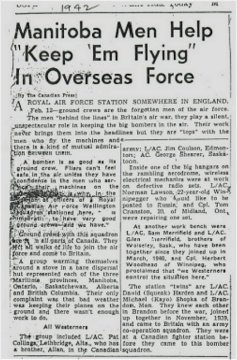 Feb.
13 (1942) - ground crews are the forgotten men of the air force. The men
"behind the lines" in Britain's air war, they play a silent supporting
role in keeping the big bombers in the air. Their work never brings them
into the headlines but they are "tops" with the men who fly the machines
and there is a kind of mutual admiration among them.
Feb.
13 (1942) - ground crews are the forgotten men of the air force. The men
"behind the lines" in Britain's air war, they play a silent supporting
role in keeping the big bombers in the air. Their work never brings them
into the headlines but they are "tops" with the men who fly the machines
and there is a kind of mutual admiration among them.
A bomber is as good as the ground
crew. Fliers can’t feel safe in the air unless they have confidence in
the men who service their machines on the ground. (unreadable)… when in
the company of officers of the Royal Canadian Air Force Wellington aircraft
when stationed here. It is imperative to have very good ground crews—and
we have.
Ground crew with the squadron
come from all parts of Canada. They come from all walks of life to join
the air force and come to Britain.
A group warming themselves around
a stove in a base dispersal hut represented each of the three Maritime
provinces, Manitoba, Ontario, Saskatchewan, Alberta and British Columbia.
Their only complaint was that bad weather was keeping their planes on the
ground and there wasn’t enough work to do.
All Westerners
The group included L/AC. Pat Collings,
Lethbridge, Alta., who has a brother Allen in the Canadian army; L/AC.
Jim Coulson, Edmonton; AC George Shearer, Saskatoon.
Inside one of the big hangars on the rambling aerodrome,
wireless electrical mechanics were at work on defective radio sets. L/AC.
Norman Lawson, 22 year-old Winnipegger who would like to be posted to Russia,
and Cpl. Tom Cranston, 20 of Midland, Ont., were repairing one set.
At another work bench were L/AC.
Sam Merrifield and L/AC. Glen Merrifield of Wellesley, Sask., who
have been together since they joined up in March, 1940, and Cpl. Herbert
Woodhead of Winnipeg, who proclaimed that "we Westerners control the station
here."
The station "twins" are L/AC.
Donald (Squeak) Harden and L/AC. Michael (Kayo) Shopka of Brandon, Man.
They knew each other in Brandon before the war, joined up together in November,
1939 and came to Britain with an army co-operation squadron. They were
at a Canadian fighter station before they came to this bomber squadron.
Wellington Dispersal by Michael Turner
Cranston Fine Arts
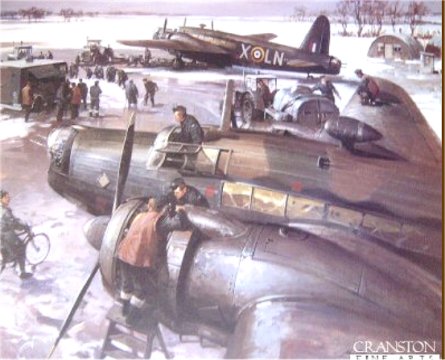 The
snapshot (left) is a print of a painting by Michael Turner in 1976. It
depicts very accurately what would have been found at Pocklington during
the winter of 1942 with two exceptions. The squadron letters "LN" need
to be changed to "LQ" to be correct for 405 squadron. The engines pictured
here are the radial PEGASUS not inline MERLINS that powered our Vickers
Wellingtons.
The
snapshot (left) is a print of a painting by Michael Turner in 1976. It
depicts very accurately what would have been found at Pocklington during
the winter of 1942 with two exceptions. The squadron letters "LN" need
to be changed to "LQ" to be correct for 405 squadron. The engines pictured
here are the radial PEGASUS not inline MERLINS that powered our Vickers
Wellingtons.
The light snow, being removed by shovel, is shown. The
NAAFI wagon with the boys lined up for a cup of hot tea and a bun shows
in the upper left hand corner. A tractor and the bomb cart train are shown
backing under the belly of aircraft "X" in the distance. The tractor pulling
a fuel tank trailer is positioned in front of the starboard mainplane of
the aircraft. The mechanic is on the mainplane waiting to take the hose
and fill the wing tank. A wireless mechanic or electrician is standing
on the pilots seat, his head out the escape hatch, shouting down to his
helper on the bicycle probably asking him to get repair parts from the
workshop in the hangar.
The two aero engine mechanics (RCAF) or fitters (RAF)
are probably cleaning spark plugs and chasing the ever elusive 'mag-drop'
which robs aircraft engines of their power. They are wearing their leather
'jerkins' which were much needed in the cold damp Yorkshire winters. One
of the fellows at the NAAFI wagon has his Wellingtons folded over, as was
the custom, to make them easier to get on and off and to reduce the rubbing
on your legs. In the upper right hand corner we see the crew shack, a Nissen
hut, which usually served three dispersal pads for three aircraft which
remained outdoors except for major repair.
~Sam Merrifield Narrative.
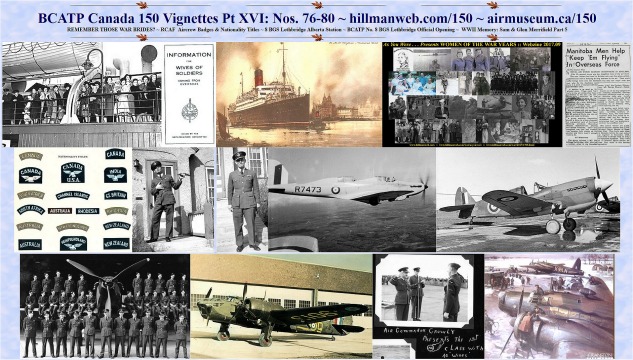
Click for full-size collage poster
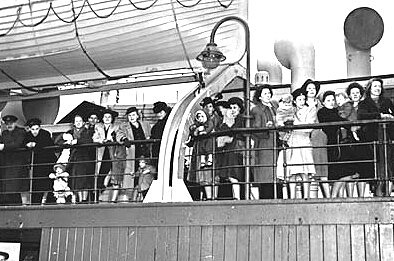
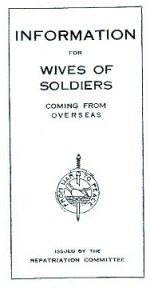
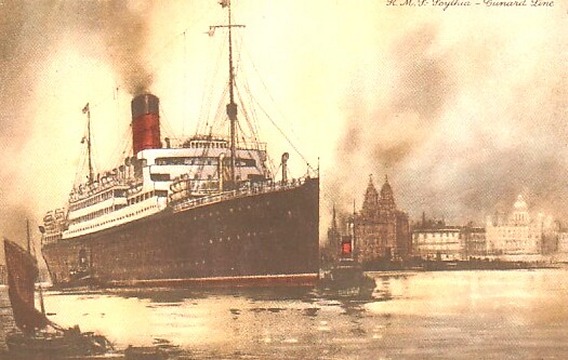
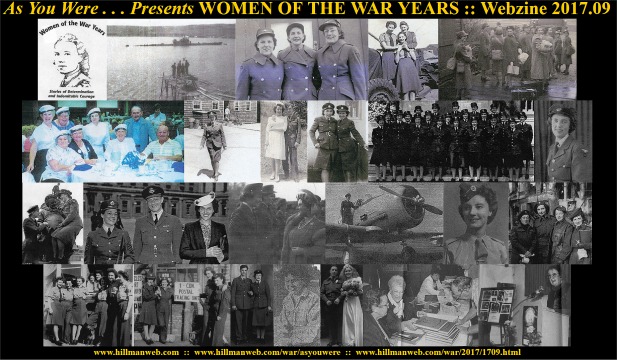

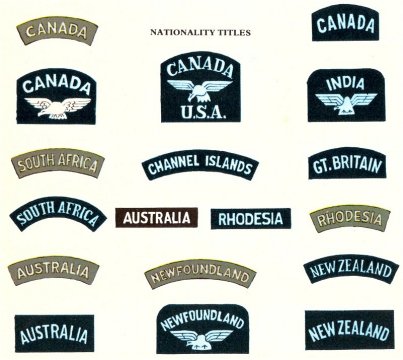
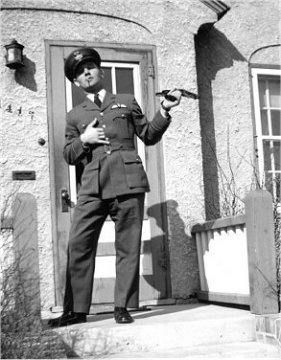 .
.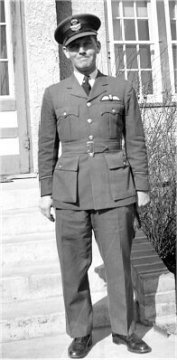
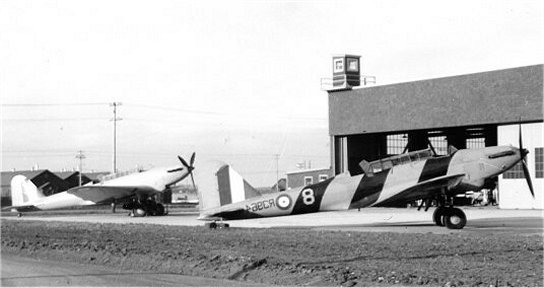
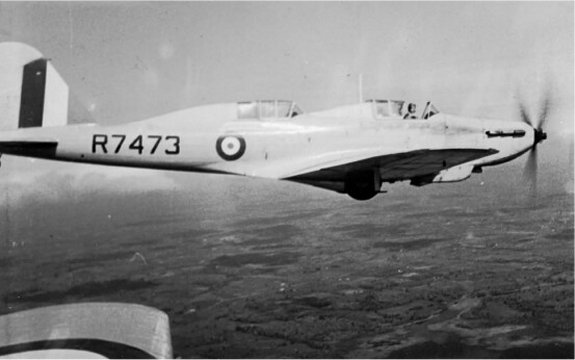
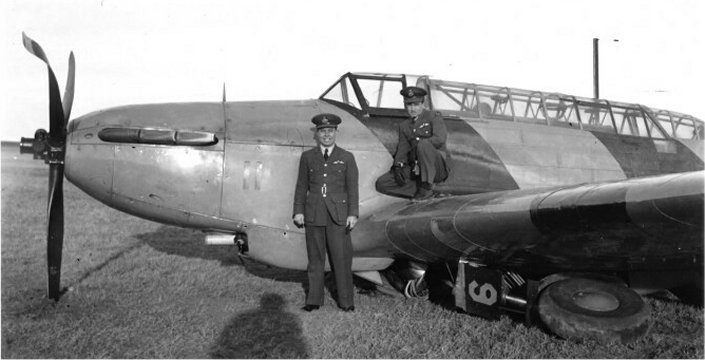
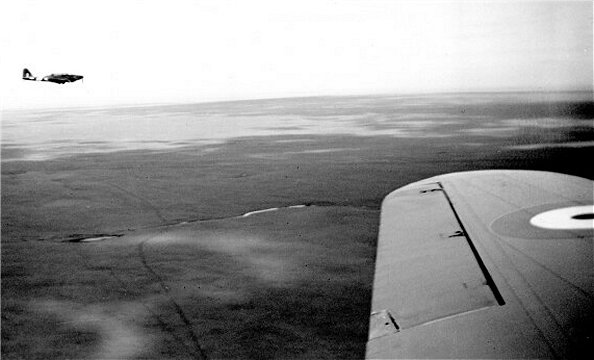
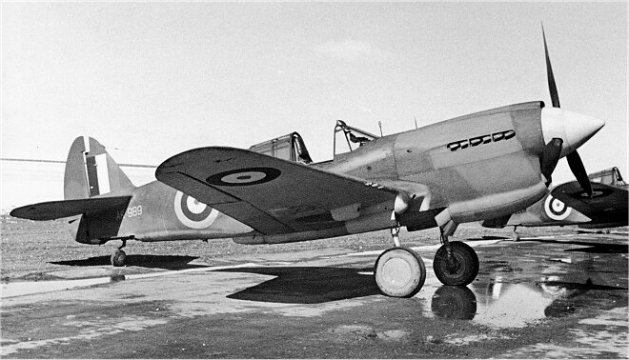
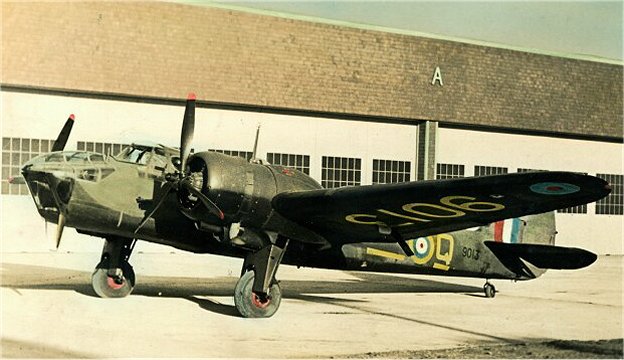



 Today
it is our pleasure to present to you, Canada's newest Bombing and Gunnery
School and its first class of Air Gunners. As you pass through the Station
today, it will be apparent that many of the buildings and facilities are
not yet completed; it is, however, very fitting that the official opening
of our Station should coincide with the graduation of. our first class,
because this is the first contribution to the sole purpose for which this
School exists, THE TRAINING OF AIR OBSERVERS AND AIR GUNNERS.
Today
it is our pleasure to present to you, Canada's newest Bombing and Gunnery
School and its first class of Air Gunners. As you pass through the Station
today, it will be apparent that many of the buildings and facilities are
not yet completed; it is, however, very fitting that the official opening
of our Station should coincide with the graduation of. our first class,
because this is the first contribution to the sole purpose for which this
School exists, THE TRAINING OF AIR OBSERVERS AND AIR GUNNERS.





 Feb.
13 (1942) - ground crews are the forgotten men of the air force. The men
"behind the lines" in Britain's air war, they play a silent supporting
role in keeping the big bombers in the air. Their work never brings them
into the headlines but they are "tops" with the men who fly the machines
and there is a kind of mutual admiration among them.
Feb.
13 (1942) - ground crews are the forgotten men of the air force. The men
"behind the lines" in Britain's air war, they play a silent supporting
role in keeping the big bombers in the air. Their work never brings them
into the headlines but they are "tops" with the men who fly the machines
and there is a kind of mutual admiration among them.
 The
snapshot (left) is a print of a painting by Michael Turner in 1976. It
depicts very accurately what would have been found at Pocklington during
the winter of 1942 with two exceptions. The squadron letters "LN" need
to be changed to "LQ" to be correct for 405 squadron. The engines pictured
here are the radial PEGASUS not inline MERLINS that powered our Vickers
Wellingtons.
The
snapshot (left) is a print of a painting by Michael Turner in 1976. It
depicts very accurately what would have been found at Pocklington during
the winter of 1942 with two exceptions. The squadron letters "LN" need
to be changed to "LQ" to be correct for 405 squadron. The engines pictured
here are the radial PEGASUS not inline MERLINS that powered our Vickers
Wellingtons.
